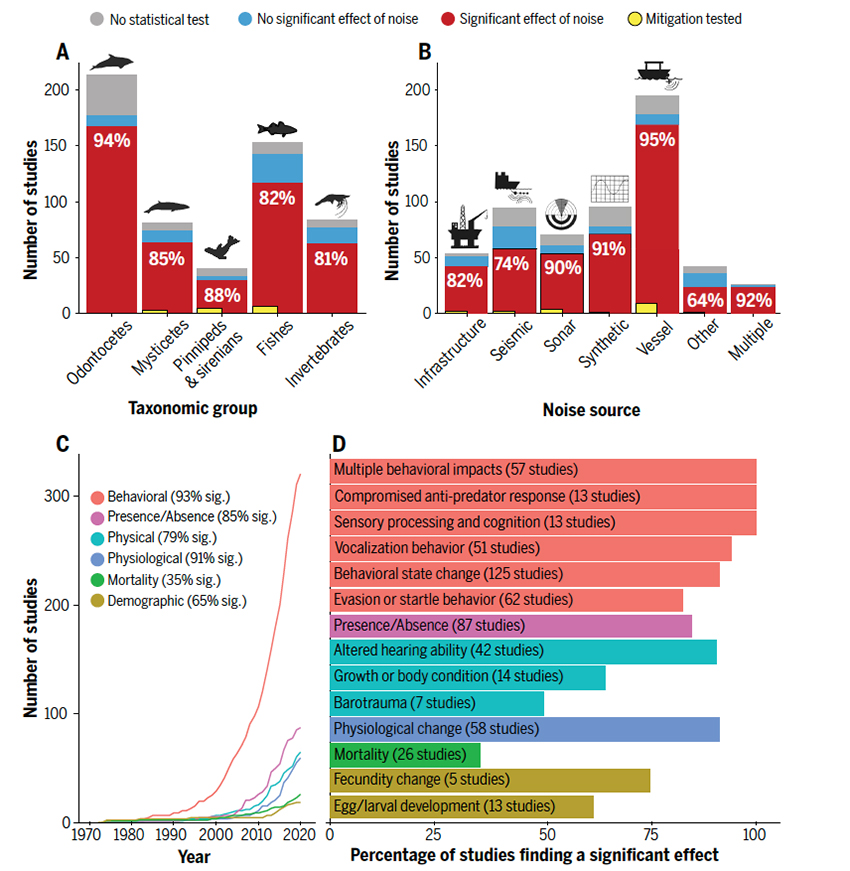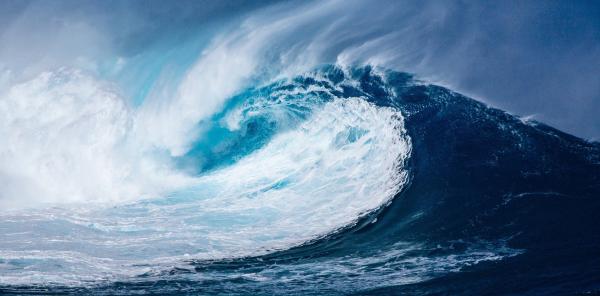Of all the sensory information available to sea creatures, chemicals, shifting light and temperature, currents, sound propagates the furthest and the fastest. Increasingly science has recognized the role of sound not just to our mammalian marine brothers and sisters but also to invertebrates like jellyfish and fishes. Like us, they have evolved with those sounds; and like us, increasing noise pollution can disrupt behavior and routines.
There are three sources of sounds within the ocean’s soundscape, those created by geography, geophony, those of biologic origins from the sea’s inhabitants, biophony, and increasingly from human sources, anthrophony. It is the changing contribution of these three components that alter the soundscape, perhaps in a harmful way.
Geophony includes the sounds created by weather, rain falling, winds gusting. It includes ice melting, glaciers calving, underground volcanoes, hydrothermal vents. Biophony includes unintentional sounds as creatures bump into the environment and one another and a much larger group of intentional sounds used to communicate, navigate, defend, hunt, and reproduce. Anthrophony includes the deliberate, the use of “high-energy, low frequency, short-duration sounds” in detecting oil and gas deposits. And the unintended, sounds of propellers and shipping – it is estimated that shipping lanes have 32 times greater low-frequency sounds than other ocean areas.
Geophony and biophony have co-evolved with life under the sea for millions of years and have found a slowly evolving equilibrium. The contribution of humans to the soundscape has occurred over a much shorter period. The rise of shipping and fishing in the last 200 years, the degradation of reefs, the increasing alterations in temperature with its effects on currents and ice, the reduction in fish populations as we continue to look to the seed to feed those on the land. It is the rapid increase in our contribution to oceanic sounds that perturbs the balance.
Measuring changes
We are not sea creatures, this is not our home, so it is not surprising that we know so little about what is all around us. Advances in acoustics have improved our ability to hear the soundscapes, while similar software advances have improved our analysis of those sounds.
Fifty years ago, the ocean's sounds first came to widespread attention in Humpback whales' recordings. Injuries to our larger mammalian cousins from our seismic investigations and military sonar use brought the deleterious effects of our sound intrusion into the ocean to our attention. Those acute events studies lead to the analysis of the more chronic alterations of sound and their consequences. Many studies are pointing to detrimental effects from changing behaviors, demographics, and physiology.

As it turns out, just as human “rock stars” and their wannabes experience hearing loss, so do the animals of the sea. While fish may recover, the hair cells associated with their hearing can regenerate; marine mammals, like us, do not regenerate those vital hairs leaving loss permanent. One need only consider one of our relatives or friends who is “hard of hearing” to recognize how debilitating this loss is in successfully navigating one’s world.
Most anthrophony is “noise” in a biological sense, because it is an unnatural and unwanted signal.
So, what to do? As with most environmental issues, it comes down to more responsible stewardship on our part or recognizing that we are a part, not the apex, of the network of life. Research funded by those great villains, oil and gas companies, are looking for ways to chart the ocean’s floor in search of oil and gas without continuing to use their current “seismic air guns.” Maersk, the world’s largest shipping company, is experimenting with changing ship design that reduces noise and conserves fuel. Reducing shipping speeds also reduces sound pollution, although the increased transit time will make the shipped goods more expensive. As with all changes, there are tradeoffs to be made.
We look to the sea for increasing resources. It behooves us to consider the alterations we have unintentionally made on land and be mindful of similar mistakes we might bring to our oceans.
Source: The Soundscape of the Anthropocene Ocean Science DOI: 10.1126/science.aba4658




